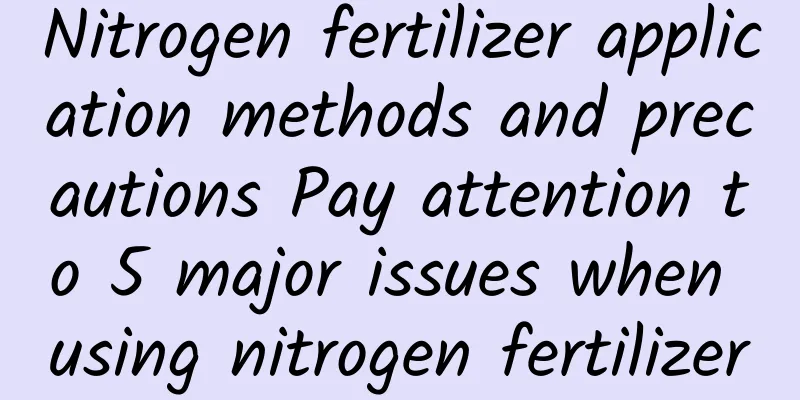Nitrogen fertilizer application methods and precautions Pay attention to 5 major issues when using nitrogen fertilizer

|
Nitrogen fertilizer is generally used as topdressing, and the depth of fertilization should be about 10 cm. Note that nitrogen fertilizer must be applied deeply and fully mixed with the soil, so that it can reduce volatilization, be absorbed by crops, and expand the nutrient area. Moreover, nitrogen fertilizer cannot be mixed with alkaline fertilizers and alkaline substances, otherwise the effect will be weakened. The following specific locations introduce what issues should be paid attention to during the use of nitrogen fertilizer. Treat various nitrogen fertilizers differently according to their characteristicsAmmonium bicarbonate and ammonia water are easy to volatilize and release ammonia, so they are suitable for deep application as base fertilizer . Nitrate nitrogen fertilizer has strong mobility in the soil and fast fertilizer effect, so it is a good topdressing fertilizer for dry fields. Ammonium nitrogen fertilizer or urea can be used as topdressing fertilizer for general paddy fields. In arid areas with less rainfall, the leaching problem of nitrate nitrogen fertilizer is not prominent, so it is more appropriate to apply nitrate nitrogen fertilizer. In rainy areas or rainy seasons, it is better to apply ammonium nitrogen fertilizer and urea. Deep nitrogen fertilizer applicationNitrogen fertilizer should be applied at a depth of about 10 cm and fully mixed with the soil. Deep application of nitrogen fertilizer can reduce the loss of fertilizer in direct volatilization, loss with water, nitrification and denitrification. Deep fertilization is also beneficial to the development of the root system, allowing the root system to grow deeper and expand the nutrient area . Reasonable application of other fertilizersWhen returning straw or green manure to the field or applying uncomposted organic fertilizer, chemical nitrogen fertilizer should be applied in combination, which plays an important role in achieving high and stable yields of crops and reducing costs. This can not only better meet the nutrient needs of crops, but also improve soil fertility. The combined application of nitrogen fertilizer and phosphorus fertilizer can improve the utilization of both nitrogen and phosphorus nutrients . According to the target yield of the crop and the nitrogen supply capacity of the soilDetermine the reasonable amount of nitrogen fertilizer, and reasonably control the ratio of base fertilizer and topdressing and the amount of nitrogen fertilizer applied during the application period, which will directly affect the amount of nitrogen available for crops to absorb. Within a certain range, crop yield and NO3 content increase with the increase of nitrogen fertilizer application. Therefore, the fertilization period and fertilization method should be as scientific and reasonable as possible . Maintain good soil moisture when applying nitrogen fertilizerThe main way for roots to absorb nitrogen is mass flow, accounting for 75% to 85%, diffusion accounts for 10% to 14%, and interception accounts for only 6% to 10%. If the soil moisture is poor, it is difficult or even impossible for the roots of crops to absorb nutrients, and fertilization is a waste. Therefore, when applying nitrogen fertilizer to plots with poor soil moisture, water should be applied in time . |
<<: What crops are suitable for planting in March? What crops can be planted in March?
Recommend
When does yellow orchid bloom?
1. Flowering time Generally speaking, yellow orch...
Diseases and Pests of Juniper and Their Control
Diseases of juniper Red blight Pathogens of junip...
How to save sweet potato seeds
Sweet potato seeds introduction Sweet potatoes ha...
Difference Between Viburnum and Hydrangea
1. Difference of blades The leaves of Viburnum ar...
How many days is the growing period of summer peanuts? When is the latest time to sow summer peanuts?
The growth cycle of summer-sown peanuts is about ...
How often should anthurium be watered in summer
Frequency of watering anthurium in summer Anthuri...
How to grow lilies in summer
1. Sufficient water Lilies like to grow in a humi...
Can crabapple be placed indoors?
1. Is it possible? If you want to grow crabapples...
Where to grow kale
Where to grow kale Kale is a vegetable crop that ...
How to DIY ivy bonsai
Prepare the Materials Abandoned wine jar (the one...
Why do the leaves of Schefflera turn yellow and fall off?
Schefflera chinensis , also known as the fortune ...
How to make hibiscus bloom more
Selecting seedlings for potted hibiscus If you wa...
How to grow the beautiful crown orchid
1. Maintenance methods 1. Temperature: 20 to 30 d...
What flowers are suitable for growing in ceramic pots? What plants are suitable for growing in ceramic pots?
How to make flowers in porcelain pots breathable ...
How does the Iron Ball survive the winter?
1. How to spend the winter 1. Temperature increas...









